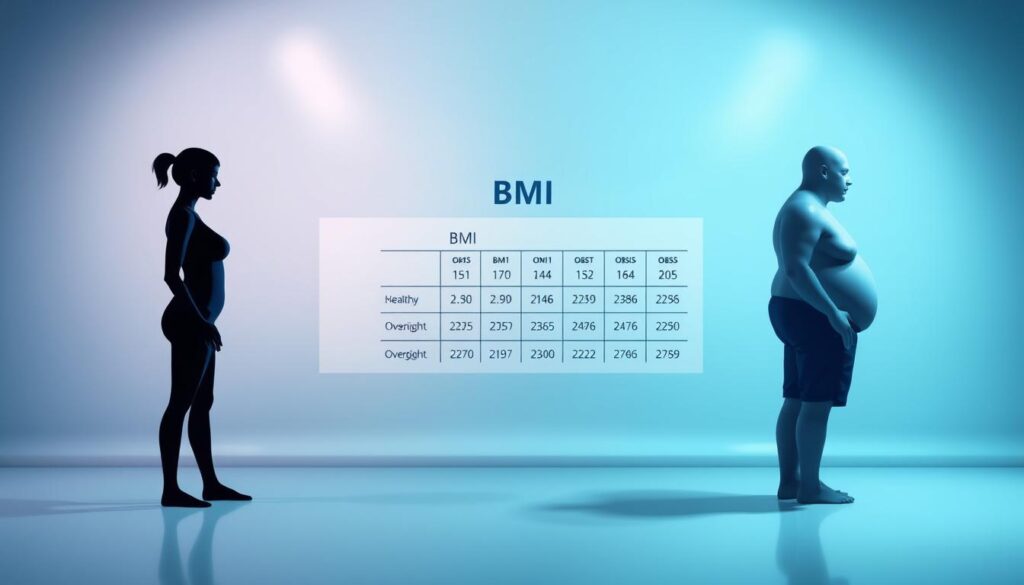Ever thought about if your weight is healthy? Body Mass Index (BMI) is a common way to check if your weight matches your height.
The Centers for Disease Control and Prevention (CDC) says BMI is a way to measure body fat. It works for adult men and women. A healthy BMI is usually between 18.5 and 24.9.
We use BMI to spot health risks like being too thin, overweight, or obese. Knowing your BMI helps you stay healthy and avoid serious diseases.
Key Takeaways
- BMI is a measure of body fat based on height and weight.
- A healthy BMI range is between 18.5 and 24.9.
- BMI is used as a screening tool for health risks.
- Understanding BMI can help in maintaining a healthy weight.
- A healthy weight can reduce the risk of chronic diseases.
Understanding BMI and Its Importance
BMI is a key indicator of health. It shows how our weight compares to our height. It’s a common tool to check if our weight is healthy.
To grasp BMI’s importance, we must understand what it is and how it’s calculated. It’s more than a number; it’s a window into our health.
What Does BMI Stand For?
BMI stands for Body Mass Index. It’s a simple way to sort people into weight categories based on height and weight.
How is BMI Calculated?
Calculating BMI is easy: it’s your weight in kilograms divided by your height in meters squared (kg/m2). For example, if you weigh 70 kilograms and are 1.75 meters tall, your BMI is 70 / (1.75)2 = 22.86.
Here’s a table to show how BMI is figured out for different heights and weights:
| Height (m) | Weight (kg) | BMI |
|---|---|---|
| 1.60 | 50 | 19.5 |
| 1.75 | 70 | 22.9 |
| 1.80 | 85 | 26.2 |
Why is BMI a Useful Measurement?
BMI is useful because it shows if your weight is healthy for your height. Health experts say, “BMI is a reliable way to check body fatness for most people. It helps find weight issues that could lead to health problems.”
“BMI is a simple, inexpensive, and non-invasive measure that can be used to assess weight status.”
Knowing about BMI helps us keep a healthy weight. It also lowers the risk of health problems linked to weight.

The BMI Categories Explained
Knowing our BMI category helps us understand potential health risks associated with our weight. The BMI categories are defined by the World Health Organization. They are widely used by healthcare professionals to assess weight-related health risks.
Underweight: Risks and Considerations
Being underweight, defined as a BMI of less than 18.5, can pose health risks. Individuals who are underweight may experience weakened immune systems, osteoporosis, and hair loss. It’s essential for underweight individuals to consult with a healthcare provider. They can help identify the underlying causes and develop a plan to achieve a healthy weight.
Normal Weight: What it Means for Us
Having a normal weight, indicated by a BMI between 18.5 and 24.9, is generally associated with the lowest risk of health problems. Maintaining a normal weight through a balanced diet and regular physical activity can help prevent chronic diseases such as heart disease and diabetes.
Overweight: Health Implications
Being overweight, with a BMI between 25 and 29.9, increases the risk of various health issues. These include high blood pressure, type 2 diabetes, and certain types of cancer. Understanding the health implications of being overweight can motivate individuals to adopt healthier lifestyles.
Obesity: Recognizing the Signs
Obesity, defined as a BMI of 30 or greater, is associated with significant health risks. These include heart disease, stroke, and certain cancers. Recognizing the signs of obesity and understanding its health implications are crucial. They are key for taking proactive steps towards a healthier weight.
| BMI Category | BMI Range | Health Risks |
|---|---|---|
| Underweight | Less than 18.5 | Weakened immune systems, osteoporosis, hair loss |
| Normal Weight | 18.5 – 24.9 | Low risk of health problems |
| Overweight | 25 – 29.9 | High blood pressure, type 2 diabetes, certain cancers |
| Obesity | 30 or greater | Heart disease, stroke, certain cancers |
How to Calculate Your BMI
To find your BMI, you need to know your weight and height. Then, use a simple formula. This calculation helps you understand your weight status and health risks.
Tools and Resources for Calculation
Many tools and resources can help you find your BMI. You can use online calculators, ask a healthcare professional, or do it yourself with a formula. For more info on BMI, check out Cleveland Clinic’s article on Body Mass.
Using Online Calculators
Online BMI calculators are easy and quick to use. Just enter your weight and height, and they do the rest. You can find these calculators on many health and wellness websites.
Benefits of using online calculators:
- Quick and easy to use
- No need to remember the formula
- Instant results
Understanding the Formula
The BMI formula is simple: weight (in kg) divided by height (in meters) squared. For example, a 70 kg person who is 1.75 m tall has a BMI of 22.86. This is found by dividing 70 by (1.75 * 1.75).

| Weight (kg) | Height (m) | BMI Calculation | BMI Value |
|---|---|---|---|
| 70 | 1.75 | 70 / (1.75 * 1.75) | 22.86 |
| 65 | 1.60 | 65 / (1.60 * 1.60) | 25.39 |
| 80 | 1.80 | 80 / (1.80 * 1.80) | 24.69 |
Learning how to calculate your BMI is the first step to assessing your weight status. It helps you make informed decisions about your health.
Limitations of BMI as a Health Indicator
BMI is a common tool for health checks, but it has its downsides. One big issue is that it doesn’t tell the difference between muscle and fat.
Does BMI Consider Muscle Mass?
BMI uses the BMI formula to figure out your health. It divides your weight by your height squared. But, it doesn’t look at muscle mass. So, people with lots of muscle might seem overweight or obese, even if they’re not.

The Role of Body Composition
BMI also doesn’t get how much fat, muscle, and other tissues you have. This means two people with the same BMI can be very different. It shows we need a better way to measure health.
Other Factors to Consider
BMI doesn’t look at bone density or body fat distribution either. For example, someone with strong bones might have a higher BMI without being too fat. Also, where fat is stored in the body is very important for health, but BMI doesn’t see that.
So, while BMI gives a basic idea of health, it’s not enough on its own. We need to use it with other measures for a clearer picture.
How BMI Affects Overall Health
A healthy BMI is key to avoiding many health issues. Keeping your BMI in the normal range is vital for your health and happiness.
Relationship Between BMI and Chronic Diseases
Research shows a strong link between BMI and chronic diseases. Being overweight or obese raises the risk of diabetes and heart disease. On the flip side, being too thin can cause osteoporosis and weaken your immune system.
Chronic diseases linked to abnormal BMI include:
- Diabetes
- Heart disease
- Certain types of cancer
- Osteoarthritis
For tips on managing weight and improving body composition, check out our guide onBMI weight loss strategies.
Mental Health and Body Image
BMI impacts not just physical health but also mental health and body image. Those with an abnormal BMI may feel unhappy with their body, have low self-esteem, and face mental health issues.
Staying within a healthy BMI range through balanced eating and exercise can boost your body image and mental health.
The Importance of Maintaining a Healthy Weight
Keeping a healthy weight is essential to avoid health problems linked to abnormal BMI. This means living a lifestyle with a balanced diet and regular exercise.
Effective ways to keep a healthy weight include:
- Eating a nutrient-rich diet
- Engaging in regular physical activity
- Monitoring weight regularly
Tips for Achieving and Maintaining a Healthy BMI
To keep a healthy BMI, you need good nutrition, regular exercise, and smart health choices. It’s not just about looking good. It’s about keeping your health in top shape. Here, we’ll share tips to help you reach and keep a healthy BMI.
Nutrition: Eating for Health
Eating right is key for a healthy BMI. You should get the right mix of proteins, carbs, fats, vitamins, and minerals. Eating lots of fruits, veggies, whole grains, and lean proteins can help you reach your weight goals.
Try to eat less processed foods, sugars, and bad fats. Controlling your portions is also important. It helps you keep your calorie intake in check.
Exercise: Finding the Right Routine
Regular exercise is crucial for burning calories and building muscle. This helps keep your BMI healthy. Find an exercise you like and can do for a long time. It could be walking, jogging, cycling, or gym workouts.
Start with at least 150 minutes of moderate exercise or 75 minutes of vigorous exercise a week. Adding strength training to your routine can also boost your metabolism and muscle mass.
Regular Check-Ups: Staying Informed
Regular health check-ups are vital for tracking your BMI and health. They help spot health problems early. This way, you can get help quickly. Plus, you get advice that fits your health needs.
At these check-ups, doctors can check your BMI, blood pressure, and more. They can also give tips on diet, exercise, and lifestyle to help your BMI and health.
| Meal | Food Items | Nutritional Benefits |
|---|---|---|
| Breakfast | Oatmeal with fruits and nuts | Rich in fiber, vitamins, and healthy fats |
| Lunch | Grilled chicken with quinoa and vegetables | High in protein, complex carbohydrates, and vitamins |
| Dinner | Salmon with brown rice and steamed broccoli | Rich in omega-3 fatty acids, complex carbohydrates, and vitamins |
Infographic: Healthy BMI Ranges
BMI ranges help us see health risks tied to weight. Knowing these ranges lets us take steps to stay healthy.
The BMI chart is easy to use. It sorts people into groups based on BMI.
| BMI Category | BMI Range | Health Risk |
|---|---|---|
| Underweight | Less than 18.5 | Malnutrition, Osteoporosis |
| Normal Weight | 18.5 – 24.9 | Low risk |
| Overweight | 25 – 29.9 | Moderate risk of chronic diseases |
| Obese | 30 or greater | High risk of chronic diseases |
Keeping a healthy BMI is key for good health. By managing our BMI, we lower the risk of health problems.
Infographic: Understanding BMI and Health Risks
Body Mass Index (BMI) is key for checking weight status and health risks. Knowing what a healthy BMI is is vital for staying healthy.
The BMI categories show different weight statuses and health risks. Recognizing these categories helps people work towards a healthy BMI.
Here’s an infographic showing how BMI affects health risks. It shows the link between BMI and chronic diseases.
Understanding BMI and health risks highlights the need for a healthy weight. This knowledge helps people make better lifestyle choices. It reduces the risk of chronic diseases and boosts overall health.


